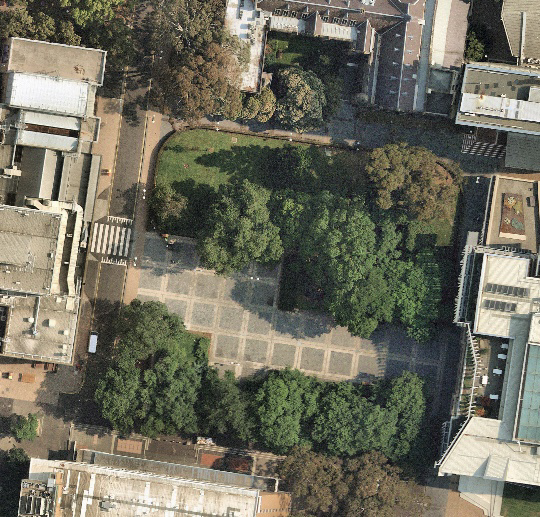Studio 5/01
Re-imagining the Concrete Lawn as a Wetland
Ray Green

Studio Theme
Before the University of Melbourne’s Parkville campus had been constructed the area currently known as the Union Lawn, or the Concrete Lawn, consisted of an area of wetland feed by a small stream. The initial development of the campus transformed this wetland into an ornamental lake, which was later filled in and replaced with a mixture of hard surfaces, plantings and other landscape features we see there today. While the stream that once flowed through this area is now piped underground, Short Finned Eels still to this day migrate from this water course to the sea to breed. The site is bordered by the Student Union, Glyn Davis Architecture Building, Raymond Priestley Building and the historic Baldwin Spencer Building. This centrally located area, while currently a much-used space, has great potential to be transformed into a new and exciting place incorporating areas of constructed wetlands that reference the original wetland that once occupied the site. Trafficable paved areas and vegetated spaces will also need to be incorporated in designs, allowing it to continue to serve the important social functions it does currently while also making it a more sustainable place in terms of energy, water and material use, waste, ecology and community, including recognition of heritage values. Students will need to consider how they will reference the wetland that once existed at this site in transforming this space to be an exciting, safe and more sustainable place for the future. In addition to referencing the wetlands that once existed at this site, students are also expected to consider the behaviour of the future users by incorporating trafficable paved surfaces, terrestrial plantings and other features that afford a broad range of activities for the users while simultaneously incorporating features that will make it a more sustainable place through considering design interventions associated with the notion of sustainable urbanism.
Theory
Wetlands and humans have had a long relationship over the course of human evolution. Viewed from this evolutionary perspective, wetlands, being inherently highly bio-diverse places, would have been important to the indigenous Australians, the Wurundjeri people, who would have relied on the wetland once occupying this site for the plant and animal resources it provided. Habitat Selection Theory suggests that contemporary humans may still possess affinities for these wetland-type environments. However, wetlands can also be perceived negatively as being “messy” and inhospitable places, issues which need to be considered.
Studio Leaders
Ray Green, who is a professor of landscape architecture in the Melbourne School of Design, will led this studio. His research focuses on sustainable land development and the benefits associated with human contact with nature in urban settings. Ray is the author or co-author of various publications related to the theme of this studio, including the books: Planning, Housing and Infrastructure for Smart Villages (2019); Coastal Towns in Transition: Local perceptions of Landscape Change (2010); The Green City: Sustainable Homes, Sustainable Suburbs (2005); Towards Low Carbon Cities in China (2015) and Design for Change (1985). Prior to joining the University of Melbourne in 1999, Ray spent 12 years in professional landscape architectural practice, at which time he undertook a variety of projects in the United States and Mexico, Asia and Australia. In 2012 he was made a Fellow of the American Society of Landscape Architects in recognition of his accomplishments in the field.
Readings & References
- Dobbie, M. and Green, R. (2013). Public perceptions of Australian freshwater
- wetlands. Urban and Landscape Planning. Vol. 110, pp. 143-154.
- Orians, G. H. and J. H. Heerwagen, J. H. (1992). Evolved responses to landscapes. In: J. H. Barkow, L. Cosmides and J. Tooby (eds.). The Adapted Mind, pp. 555-579, Oxford University Press
- Orians, G. H. (1986). An ecological and evolutionary approach to landscape
- aesthetics. pp. 3-22. In: E. C. Penning-Rowsell and D. Lowenthal (eds.) Landscape Meanings and Values, London, Allen & Unwin
Schedule Tuesdays 15:15-18:15, Thursdays 18:15-20:15 | Lecture Thursdays 15:15-16:15